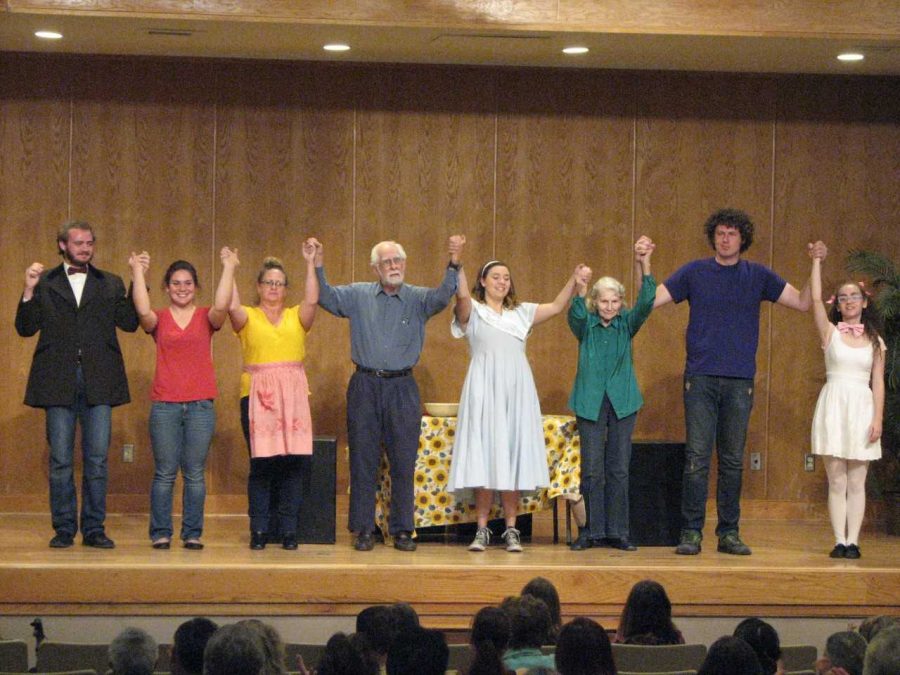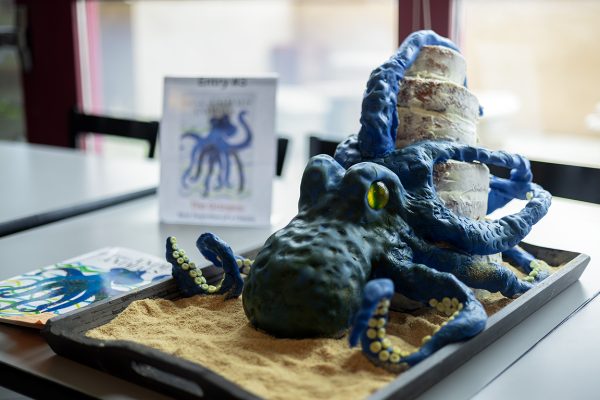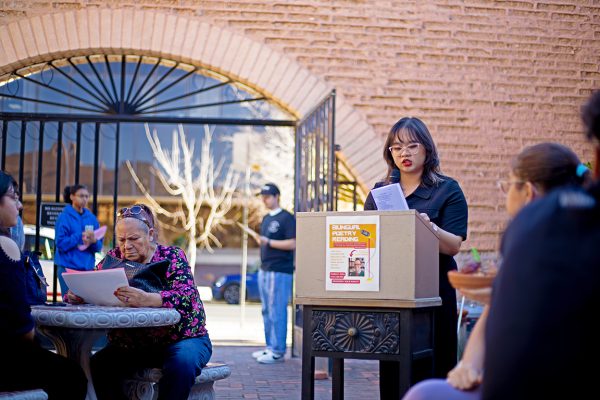‘Down the Rabbit Hole’ play sheds light on Parkinson’s Disease
Down the Rabbit Hole with Dr. Parkinson is a new play directed by New Mexico State University Assistant Professor of Theatre Nichole Hamilton and assistant-directed by NMSU Theatre Arts major Maggie Jane Simpson. It educates its audience about Parkinson’s disease while entertaining. The show had five performances from April 5 until April 8.
The play was created through a series of workshops during fall 2017. It centers around stories that real people with Parkinson’s disease have experienced, and explains how Parkinson’s disease affects the brain, as well as its symptoms. The piece was a blend of actors and non-actors, students and teachers, and people who have Parkinson’s disease and people who do not have it.
Down the Rabbit Hole with Dr. Parkinson is made up of an ensemble cast, which includes: Sammi Armstrong as Alice, Elaine Brink as Grandma, Dormouse, and Caterpillar, Xodia Choate as the Bunny, Timothy Ecton as Dr. Parkinson, John Hamilton as Grandfather, Michael Holt as Brother, Train Passenger, Mad Hatter, and De, Jaidan Jaramillo as Sister, Train Passenger, March Hare, and Dum, and Kay Lilley as Mom, Train Passenger, and Queen of Hearts.
John Hamilton brought the idea of this project to NMSU’s Theatre Arts department. His goal is to establish a Disease Registry for Parkinson’s in New Mexico.
“We are within inches of getting a registry. But the problem that we have is money, funding for the conference,” said John Hamilton. He continued, “We need to get the attention of people, locally and statewide, about the subject of Parkinson’s.”
Trying to find a way to reach his local community, Hamilton said, “I thought about theatre. Now, I’m not a theatre person, but I thought that it was a wonderful way of approaching the problem of Parkinson’s disease.”
Simpson, Assistant Director in the project, added that the primary goal for our project was to raise awareness, and second, have a disease registry for persons with Parkinson’s in New Mexico.
The story begins with Alice, the main character, played by Sammi Armstrong, an NMSU Theatre Arts major, at dinner with her family. When her Grandfather, played by John Hamilton, experiences tremors brought on by his Parkinson’s, the family reacts negatively. This confuses Alice.
Alice then goes on an adventure through the brain and wonderland. Alice meets Dr. Parkinson, played by Timothy Ecton, an NMSU Theatre Arts major. Dr. Parkinson and the ensemble teach Alice about Parkinson’s disease through a game of red light/green light, a tea party, a hallucination, and a misadventure at a bank.
After leaving wonderland, Alice returns to dinner with her family, where her Grandfather re-experiences his tremors. This time, though, Alice understands what her Grandfather is going through and responds positively.
Nichole Hamilton explained that she and John Hamilton “…sat down and talked about what the mission of the project would be. And I think he really wanted to do a play that would entertain, educate, engage the community, raise awareness about Parkinson’s, and hopefully instigate advocacy. And I was all in agreement with that.”
Armstrong said that “The rehearsal process was interesting because we didn’t have the whole play at the beginning so we would rehearse a scene or rehearse a concept and make it into a scene.”
Kay Lilley, another member of the cast, explained that she “found the entire experience really fascinating”.
“The process was unfamiliar to me because I’ve never been involved in theatre, much less being part of the creative team and the writing team” said Lilley. “The process was really cool and I really loved that we used real experiences from people who have shared their stories with us. To me, that made it even more meaningful.”
Regarding the outcome of the project, John Hamilton said that, it had turned out to be a remarkable experience, and he hopes that it’s something that can bear fruit in form of better therapy, better understanding of how Parkinson’s works.”

Émilie Rasmussen is in her first year at NMSU and as a Staff Writer for The Round Up. She graduated from El Dorado High School and the International Baccalaureate...













Cherry Dotman • Apr 20, 2024 at 3:32 PM
I am a 64 year old female, I was diagnosed of Parkinson disease PD in 2015, my symptoms started out with severe fatigue, poor balance, numbness, double vision, heat intolerance and anxiety. I was unable to go back to work, I tried Betaseron for about 6 years. Tried every shot available, all made me sick. In November 2023, I started on Parkinson disease PD Herbal formula from multivitamincare org , the treatment worked incredibly for my MS condition. I used the Natural PD Herbal formula for a total time period of 3 months, it totally reversed Parkinson disease PD . I had a total decline of all symptoms including vision problems, numbness and others. Sometimes, i totally forget i ever had PD.
Kate Maurice • Nov 15, 2023 at 5:03 PM
Am very happy telling everyone here my testimony i am Ashley Miller from united state, am a nurse,this is a story of my love life.I have been married for 4 years and on the 5th year of my marriage, another woman had to take my husband away from me living me and the kids to suffer for 2 years until i met a post where this man Dr. Ehi have helped so many people in the relationship and i decided to give him a try to help me bring my husband back home and believe me all i did was to send my picture to him and that of my husband and after 48 hours as he have told me, i saw a car drove into the house and behold it was my husband and he have come to me and the kids and that is why i am happy to share to everyone having similar problem to meet with this man and have your lover back to yourself. You can contact him with this email address shomorikasolutiontemple @ yahoo . com Thank you Dr Ehi. I am sure he will do same to help you all
Victoria • Sep 25, 2021 at 3:14 AM
My dad was diagnosed with Parkinson’s disease.his symptoms were shuffling of feet,slurred speech, low volume speech, degradation of hand writing, horrible driving skills, right arm held at 47 degree angle, but now he finally free from the disease with the help of total cure from ULTIMATE LIFE CLINIC, he now walks properly and all symptoms has reversed, he had trouble with balance especially at night, getting into the shower and exiting it is difficult,getting into bed is also another thing he finds impossible.we had to find a better solution for his condition which has really helped him a lot,the biggest helped we had was ultimate life clinic they walked us through the proper steps,am highly recommended this http://www.ultimatelifeclinic.com to anyone who needs help.
rose • May 5, 2019 at 9:36 AM
I am very happy today with my family. My name is rose living in USA, My
husband left me for a good 3 years now, and i love him so much, i have been
looking for a way to get him back since then. i have tried many options but
he did not come back, until i met a friend that darted me to Dr.love a
spell caster, who helped me to bring back my husband after 2 weeks. Me and
my husband are living happily together today, That man is great, you can
contact him via email [email protected] Now i will advice any serious
persons that found themselves in this kind of problem to contact him now a
fast solution without stress.. He always hello, now i call him my
father.contact him now he is always online email [email protected]
or whatsapp number +2349031349407
Grace Purg • Sep 28, 2018 at 11:21 PM
was diagnosed with Parkinson”s syndrome in may of last year. I had essential tremors since age 55. I have a stooped posture, right arm was not moving. I also have a pulsating feeling in my body. My legs tingle and they were cold.i was advised to give a try on Total cure herbal foundation herbal formula by my doctors which i truly did and the herbal treatment help me get rid Parkinson disease PD within the short period of 15 weeks usage,please do not hesitate to place an order from them at totalcureherbsfoundation .com because the herbal products relief me automatically and terminated all the symptoms.
Maureen Stewart • Sep 14, 2018 at 1:08 AM
I was diagnosed 2 years ago at age 63. Symptoms were tremor in right leg, loss of handwriting ability, and soft voice. I also have difficulty rising from a seated position and have balance issues. I started out taking only Azilect, then Mirapex, and 6 months ago Sinemet. Several months ago I started falling frequently, hence the reason for Sinemet. I tried every shots available but nothing worked. In June 2018, my neurologist and I decided to go with natural treatment and was introduced to Natural Herbal Gardens natural organic Parkinson’s Herbal formula, i had a total decline of symptoms with this treatment, the Tremor, falling frequently, stiffness, body weakness, balance issues, depression and others has subsided. Visit Natural Herbal Gardens official website ww w. naturalherbalgardens. com. This treatment is a breakthrough for all suffering from Parkinson’s, don’t give up Hope. Keep Sharing the Awareness, herbs are truly gift from God.
Grace Purg • Sep 4, 2018 at 6:05 AM
I was diagnosed with Parkinson”s syndrome in may of last year. I had essential tremors since age 55. I have a stooped posture, right arm was not moving. I also have a pulsating feeling in my body. My legs tingle and they were cold.i was advised to give a try on Total cure herbal foundation herbal formula by my doctors which i truly did and the herbal treatment help me get rid Parkinson disease PD within the short period of 15 weeks usage,please do not hesitate to place an order from them at http://www.totalcureherbsfoundation.com because the herbal products relief me automatically and terminated all the symptoms.
ROSE WAYNE • Aug 15, 2018 at 5:39 AM
i am so glad to write this article today to tell the world how Chief Dr Lucky cured my HPV virus that have been in my body since five years ago, ever since then my life has been in complete,i have used so many drugs that was prescribed to me by several doctors,but it didn’t cure my HPV VIRUS neither did it reduce the pain, i was checking for solution on the internet then miraculously came across Chief Dr Lucky the powerful herbalist that cure HPV INFECTION,then i contacted his email, i explained everything to him and he prepared a herbal cure and send it to me that was how i got cured from HPV disease totally after receiving his herbal medicine, so my friends viewers why waiting and be suffering with this HPV virus when there is someone like Chief Dr Lucky that can cure any disease HIV/ CANCER/ HEPATITIS C VIRUS,HERPES VIRUS,ALS VIRUS. you can contact his via email: [email protected] .Whats App or call +2349065398067
wilson kita joyce • Aug 15, 2018 at 5:18 AM
I was in trouble when my doctor told me that i have been diagnosed with
herpes and i know my family will face a serious problem . when i am gone i
lost hope and wept most of the time, but one day i was surfing the internet
i saw Dr. bante herbal home contact number online i called him and he
guided me. i asked him for solutions and he started the remedy for my
health thank God,now everything is fine i am cured by Dr. bante herbal
medicine am very thankful to Dr. bante and very happy with my hobby and
family email him on ([email protected]) call/whatsapp number +2347059073543
([email protected])
He can as well cure the following disease;
Herpes,
Asthma,
Cancer,
HSV1, &
HSV2,
Hepatitis B,
HIV/AID ETC.
Have a nice day people.
……
wilson kita joyce • Aug 15, 2018 at 5:18 AM
I was in trouble when my doctor told me that i have been diagnosed with
herpes and i know my family will face a serious problem . when i am gone i
lost hope and wept most of the time, but one day i was surfing the internet
i saw Dr. bante herbal home contact number online i called him and he
guided me. i asked him for solutions and he started the remedy for my
health thank God,now everything is fine i am cured by Dr. bante herbal
medicine am very thankful to Dr. bante and very happy with my hobby and
family email him on ([email protected]) call/whatsapp number +2347059073543
([email protected])
He can as well cure the following disease;
Herpes,
Asthma,
Cancer,
HSV1, &
HSV2,
Hepatitis B,
HIV/AID ETC.
Have a nice day people.
myers • Aug 14, 2018 at 1:04 PM
I was diagnose of Chronic Obstructive Pulmonary Disease (COPD) 2 years ago, my family doctor told me there is no cure but it can only be controled. Ever since then i have been running heather scepter looking for a solution to my problem because i was going to lose my Job if i dont get better, until i ran into this online testimony of Mrs Stacey who have been cured of COPD by this herbal clinic in Africa (Astoria Herbal Clinic), i immediately contacted them via their email ([email protected]), to God be thy glory i bought this COPD herbal remedy and was cured within 3 weeks of usage, at last this is a break through for all COPD patients contact this herbal clinic via their email [email protected] or whasapp +2349051441669
Danny • Jul 25, 2018 at 6:47 AM
Final breakthrough for all suffering from Parkinson’s disease…My father is 73 and was diagnosed with Parkinson’s about 2 years ago. He deals with a lot of anxiety, so much so that he doesn’t want to go out, doesn’t want to be with people. My brother has to beg him to be with family. I feel that natural supplements are so important, but he depends only on the drug levodopa, his meds for the a-fib, and anti depression medicine. Last three months my brother working in India purchased PD herbal remedy from Best Health Herbal Centre. My father only used the PD herbal remedy for 6 weeks without levodopa and all his symptoms was completely reversed. My father is now happily living Parkinson’s diseases free now ….I recommend this Parkinson’s herbal remedy for all Parkinson’s Patients. Visit w ww .besthealthherbalcentre. c om for more detail…Thanks…
Shirley Klassen • Jul 24, 2018 at 10:40 AM
The love of my life for the last 17 years was diagnosed with Parkinson’s disease nearly 4 years ago, at age 52. He had a stooped posture, tremors, muscle stiffness, horrible driving skills, and slow movement. He was placed on Sinemet 50/200 at night for 7 months and then Sifrol and rotigotine were introduced which replaced the Sinemet but he had to stop due to side effects. He started having hallucinations, lost touch with reality. Suspecting it was the medications I took him off the Siferol (with the doctor’s knowledge) In March this year his primary physician suggested we started him on Natural Herbal Gardens Parkinson’s Herbal formula which eased his anxiety a bit, i’m happy to report this PD herbal treatment worked very effectively. His Parkinson’s is totally under control, he had a total decline in symptoms, the tremors, shaking, stiffness, slow movement and speech problems stopped. Visit Natural Herbal Gardens official web page naturalherbalgardens . c o m. My family are amazed at the change and rapid improvement. This herbal treatment is a breakthrough for all PD sufferers. SHARE WITH FRIENDS!!
megan fox • Jul 8, 2018 at 5:51 PM
I was diagnosed of Parkinsons disease when i was 51. I had hand tremors, restless sleep, muscle weakness, cognitive decline, voice spasm, stiff achy right arm and ankle, I felt like giving up the ghost but no, i don’t wanna give up on the fight so i have to keep on with the battle till i succeed…With the progressive parkinson’s disease symptoms on me , everything was worsened, with my neurologist guidance i started on natural alternative PARKINSONS DISEASE treatment from MADIDA HERBAL CENTER. you’re not gonna believe it that it works out so well that their herbal PD formula reversed my parkinson’s disease, right now i feel better and don’t long feel any pain nor PD symptoms anymore. visit their websit: www .madidaherbalcenter .weebly .com or Email them directly at: [email protected] for your health problems and remedies.
Kimberly Ferguson • Jun 20, 2018 at 9:29 PM
I am 63 year old who was diagnosed 8 months ago with Parkinson’s. I had severe calf pain, muscle pain, slurred speech, frequent falls, loss of balance, difficulty in getting up from sitting position, I was having a problem accepting my diagnosis, even though I read every thing I could find to read. I was put on Sinemet 3 times daily but it didn’t seem to be helping. After 4 months of been diagnosed I was having difficulty writing. Getting in bed, turning over. There has been little if any progress in finding a cure or reliable treatment. So this year our primary physician suggested I started on Natural Herbal Gardens Parkinson’s Herbal formula which eased my anxiety a bit,We ordered their PD herbal treatment after reading alot of positive reviews, i am happy to report with the help of Natural Herbal Garden natural herbs I have been able to reverse my symptoms using herbs,8 weeks into treatment I improved dramatically. At the end of the full treatment course, the disease is totally under control. No case of Slurred Speech, loss of balance, or weakness. Visit Natural Herbal Gardens official website www. naturalherbalgardens .com This Herbal Protocol is Incredible!! My life is back.
George • May 19, 2018 at 2:55 AM
Diagnosed last June after almost a year of many, many specialists telling me they had no idea what was wrong. My symptoms were all non-motor, insomnia, leg pain that will not go away, and anxiety issues. Had a DAT scan and that was the test that verified PD.
Started on Requip, had such bad fatigue that I had to quit that and then started on Sinemet, no changes too. My son purchased PD herbal remedy online from Best Health Herbal Centre. My son said (Best Health Herbal Centre) to him that the herbal remedy will reverse my PD under 6 weeks. So after using the PD herbal remedy for 6 weeks, my PD was totally reversed. No more major fatigue, insomnia is better, leg pain disappeared. I can walk 4 miles now without feeling pain.
I am 64, was diagnosed at 63. I thought i will die with brain fog and fatigue, but Best Health Herbal Centre saved my life.
Please get your PD herbal remedy immediately via their website: ww w .besthealthherbalcentre. com
Jose Ava • May 7, 2018 at 12:34 AM
My symptoms started at the age of 46. My fingers on my left hand were stiff and were difficult to move. People noticed that my walk was not normal. I was often asked did I hurt. I noticed nothing different about my walk. It was difficult getting up from` a chair and getting out of a car. I was diagnosed a year later and i have to find a better solution and was introduced to try the help of herbal formula. I am now 59 tho and am fully cured from Parkinson’s disease.
contact Total Cure Herbal Foundation on: [email protected] or visit their website at https://totalcureherbalfou5.wixsite.com/herbal/contact i had to use the remedies for 15 weeks usage which really help on my condition.
Ava
Francess Raphel • Apr 25, 2018 at 10:02 AM
I am a 59-year-old woman. My Parkinson’s disease appeared at the age of 57. My symptoms, at the beginning, were fine tremors and rigidity with joint stiffness. My neurologist prescribed entacapone with levodopa, carbidopa, and pramipexole. I opted not to go on prescription medicines but decided on using herbs instead, October 18, 2017 after being on the herbs you recommended, i had a total recovery from Parkinson’s disease with this natural herbal formula treatment. The tremors, Shaking, Joint Stiffness has subsided. When I stumbled upon you guys, it was just pure instinct. And from that day on it has been one of the best decisions I’ve made in my life. The caring that goes into explaining what herbs work for whatever ails me is astounding. In today’s world where so many are after a quick buck, selling without care, Natural Herbal Garden’s staffs amplifies the difference. I’m a believer in karma, and for generations to come, this is a herbal store that will be leaving it’s footprint in this world. Visit NATURAL HERBAL GARDENS official web site http://www.naturalherbalgardens.com A world of thanks to The Natural Herbal Gardens!”
Francess Raphel • Apr 25, 2018 at 10:02 AM
I am a 59-year-old woman. My Parkinson’s disease appeared at the age of 57. My symptoms, at the beginning, were fine tremors and rigidity with joint stiffness. My neurologist prescribed entacapone with levodopa, carbidopa, and pramipexole. I opted not to go on prescription medicines but decided on using herbs instead, October 18, 2017 after being on the herbs you recommended, i had a total recovery from Parkinson’s disease with this natural herbal formula treatment. The tremors, Shaking, Joint Stiffness has subsided. When I stumbled upon you guys, it was just pure instinct. And from that day on it has been one of the best decisions I’ve made in my life. The caring that goes into explaining what herbs work for whatever ails me is astounding. In today’s world where so many are after a quick buck, selling without care, Natural Herbal Garden’s staffs amplifies the difference. I’m a believer in karma, and for generations to come, this is a herbal store that will be leaving it’s footprint in this world. Visit NATURAL HERBAL GARDENS official web site www. naturalherbalgardens. com A world of thanks to The Natural Herbal Gardens!”
Josef Martindale • Apr 16, 2018 at 11:11 PM
I am a 49-year-old man. My Parkinson’s disease appeared at the age of 47. My symptoms, at the beginning, were fine tremors and rigidity with joint stiffness. My neurologist prescribed entacapone with levodopa, carbidopa, and pramipexole. I opted not to go on prescription medicines but decided on using herbs instead, October 18, 2017 after being on the herbs you recommended, i had a total recovery from Parkinson’s disease with this natural herbal formula treatment. The tremors, Shaking, Joint Stiffness has subsided. When I stumbled upon you guys, it was just pure instinct. And from that day on it has been one of the best decisions I’ve made in my life. The caring that goes into explaining what herbs work for whatever ails me is astounding. In today’s world where so many are after a quick buck, selling without care, The Herbal Garden’s staffs amplifies the difference. I’m a believer in karma, and for generations to come, this is a herbal store that will be leaving it’s footprint in this world. Visit THE HERBAL GARDENS official web site www. theherbalgardens. org A world of thanks to The Herbal Gardens!”
Shorai Erikson • Apr 10, 2018 at 6:39 PM
Parkinson’s symptoms first appeared when I was 68. I noticed a vibration in right foot and then right hand. After about 18 months a shake and/or tremor. Twelve months later, shaking. My neurologist. Started me on entacapone,levodopa, carbidopa, and pramipexole to reduce symptoms and slow down progression but I could not tolerate them for long due to severe side effects. I decided to adopt a more natural approach and started on Parkinson’s Disease Herbal formula from Green House Herbal Clinic, the PD natural formula immensely helped my condition, i had a total recovery from Parkinson’s disease with this natural herbal formula treatment. Visit Green House Herbal Clinic official web site w w w . greenhouseherbalclinic . Weebly . com. I feel alive again! The tremors, Shaking, Joint Stiffness and other symptoms has subsided. I am very pleased with this treatment. I feel very well now and exercise regularly, sometimes i totally forget i ever had Parkinson’s, My family are amazed at the change and rapid recovery from PD. since the procedure I enjoy walking the dog for my daily exercise. DON’T GIVE UP HOPE!!!
Shorai Erikson • Apr 10, 2018 at 6:38 PM
Parkinson’s symptoms first appeared when I was 68. I noticed a vibration in right foot and then right hand. After about 18 months a shake and/or tremor. Twelve months later, shaking. My neurologist. Started me on entacapone,levodopa, carbidopa, and pramipexole to reduce symptoms and slow down progression but I could not tolerate them for long due to severe side effects. I decided to adopt a more natural approach and started on Parkinson’s Disease Herbal formula from Green House Herbal Clinic, the PD natural formula immensely helped my condition, i had a total recovery from Parkinson’s disease with this natural herbal formula treatment. Visit Green House Herbal Clinic official web site ww w. greenhouseherbalclinic. Weebly. com. I feel alive again! The tremors, Shaking, Joint Stiffness and other symptoms has subsided. I am very pleased with this treatment. I feel very well now and exercise regularly, sometimes i totally forget i ever had Parkinson’s, My family are amazed at the change and rapid recovery from PD. since the procedure I enjoy walking the dog for my daily exercise. DON’T GIVE UP HOPE!!!
evelyn • Apr 9, 2018 at 7:08 PM
My parkinson is totally under control through PD herbal treatment from Rich Herbs Foundation, i had a total decline in symptoms, the tremors, shaking, stiffness, congnition and speech problems stopped. Visit rich herbs foundation official web page w w w. richherbsfoundation. c o m. I am happy to report this PD herbal treatment worked very effectively. My family are amazed at the change and rapid recovery from parkinsons disease.
Evelyn ray • Apr 9, 2018 at 5:51 PM
In April of last year, i started on natural parkinsons disease herbal treatments from RICH HERBS FOUNDATION, i am happy to report this PD herbal treatment worked very effectively. My parkinson is totally under control, i had a total decline in symptoms, the tremors, shaking, stiffness, congnition and speech problems stopped. Visit rich herbs foundation official web page w w w. richherbsfoundation. c o m. My family are amazed at the change and rapid recovery from parkinsons disease.